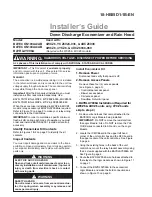
- 75 -
Check code
Meaning, detecting method
Cause
Checking method & Countermeasure
Serial
transmission
abnormality
0403
If serial transmission cannot be
established between the MAIN and
INV boards.
1) Wiring is defective.
2) Switches are set wrong on the INV
board.
3) A fuse (F01) on the INV board is
defective.
4) The circuit board is defective.
Check 1, the connections, 2, contact
at the connectors and 3, for broken
wires in the following wiring.
CNRS2 - CNRS3
CNAC2 - TB1B
SW1-4 on the INV board should be
OFF.
If the fuse is melted, (if the resistance
between the both ends of fuse is
∞
),
replace the fuse.
If none of the items in 1) to 3) is appli-
cable, and if the trouble reappears even
after the power is switched on again,
replace the circuit board by the follow-
ing procedure (when replacing the cir-
cuit board, be sure to connect all the
connectors, ground wires, etc. se-
curely).
1
If serial transmission is restored af-
ter the INV board only is replaced,
then the INV board is defective.
2
If serial transmission is not restored,
reinstall the INV board and replace
the MAIN board. If serial transmis-
sion is restored, the MAIN board is
defective.
3
If serial transmission is not restored
by
1
and
2
above, replace both
boards.
Discharge
temperature
abnormality
(Outdoor unit)
1102
1. When 140˚C or more discharge
temperature is detected during
operations (the first time), out-
door unit stops once, mode is
changed to restart mode after
3 minutes, then the outdoor unit
restarts.
2. When 140˚C or more temp. is
detected again (the second
time) within 30 minutes after
stop of outdoor unit, emergency
stop is observed with code No.
“1102” displayed.
3. When 140˚C or more temp. is
detected 30 or more minutes
after stop of outdoor unit, the
stop is regarded as the first time
and the process shown in 1 is
observed.
4. 30 minutes after stop of outdoor
unit is intermittent fault check
period with LED displayed
(1202).
See
Refrigerant amount check.
Check operating conditions and opera-
tion status of indoor/outdoor units.
Check operation status by actually
performing cooling or heating opera-
tions.
Cooling
: Indoor LEV
Outdoor LEV1
See
Trouble check of LEV and sole-
noid valve.
Check address setting of indoor unit
connection.
Confirm that ball valve is fully opened.
Check outdoor fan.
See
Trouble check of outdoor fan.
Check operation status of cooling-only
or heating-only.
See
Trouble check of solenoid
valve.
Check resistance of thermistor.
Check inlet temperature of sensor
with LED monitor.
1) Gas leak, gas shortage.
2) Overload operations.
3) Poor operations of indoor LEV.
4) Poor operations of OC controller
LEV
5) Setting error of connection
address.
6) Poor operations of ball valve.
7) Outdoor unit fan block, motor
trouble, poor operations of fan
controller
→
Heating (Heating-only,
Heating-main).
3) ~ 7) : Rise in discharge
temp. by low pressure drawing.
8) Gas leak between low and high
pressures.
4-way valve trouble, compres-
sor trouble, solenoid valve
SV1 trouble.
9) Poor operations of solenoid valve SV2.
Bypass valve SV2 can not
control rise in discharge temp.
10)Thermistor trouble.
11)Thermistor input circuit trouble on
control circuit board.
3
3
Self-Diagnosis and Problem-Solving Using Check Codes
[1] Mechanical
















































